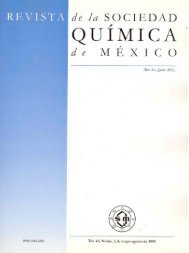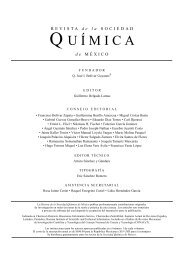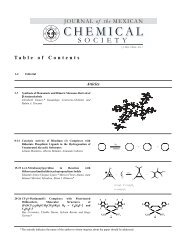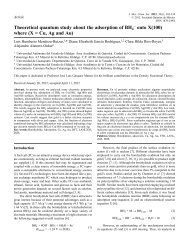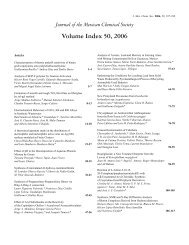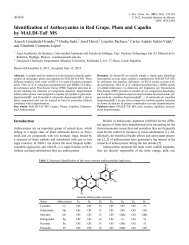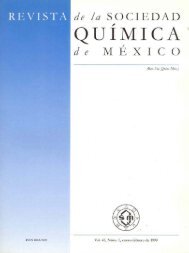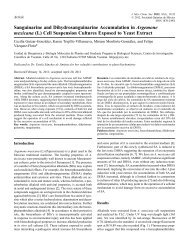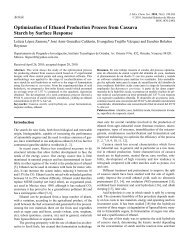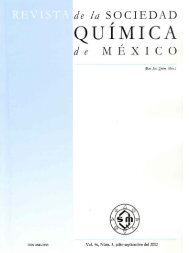SMQ-V047 N-002_ligas_size.pdf - Journal of the Mexican Chemical ...
SMQ-V047 N-002_ligas_size.pdf - Journal of the Mexican Chemical ...
SMQ-V047 N-002_ligas_size.pdf - Journal of the Mexican Chemical ...
You also want an ePaper? Increase the reach of your titles
YUMPU automatically turns print PDFs into web optimized ePapers that Google loves.
Sesquiterpene Lactone Sequestration by <strong>the</strong> Tortoise Beetle Physonota arizonae (Cassidinae) 145<br />
In fur<strong>the</strong>r analysis, <strong>the</strong> chlor<strong>of</strong>orm washings were combined<br />
and <strong>the</strong> solvent evaporated to yield a green resinous<br />
material. The green resinous material was dissolved in<br />
methanol to remove <strong>the</strong> lipid fraction, and filtered. The filtrate<br />
was concentrated and applied to a Sephadex LH-20 chromatographic<br />
column and eluted with methanol. Several fractions<br />
were collected and tlc analysis revealed that fractions 5 and 6<br />
contained <strong>the</strong> two major constituents <strong>of</strong> <strong>the</strong> fecal excretions<br />
identical to <strong>the</strong> ones originally detected by tlc. Final purification<br />
<strong>of</strong> <strong>the</strong> constituents <strong>of</strong> fractions 5 and 6 was achieved by<br />
preparative tlc. The 1 H-NMR spectra <strong>of</strong> fractions 5 and 6 had<br />
a very important diagnostic value in determining that fraction<br />
5 contained a sesquiterpene lactone (i.e., doublets at 6.27 and<br />
5.57 ppm with a coupling constant <strong>of</strong> approximately 3 Hz corresponding<br />
to <strong>the</strong> two protons in <strong>the</strong> exocyclic double bond<br />
<strong>of</strong> <strong>the</strong> γ-butyrolactone), and that fraction 6 contained a structurally<br />
related compound. This initial finding suggested that<br />
<strong>the</strong> origin <strong>of</strong> <strong>the</strong>se sesquiterpene lactones was actually <strong>the</strong><br />
host-plant. The sesquiterpene lactone chemistry <strong>of</strong> A. ambrosioides<br />
has been previously reported [12-14] and it is known<br />
that <strong>the</strong>re are geographical variations in <strong>the</strong> chemistry <strong>of</strong> A.<br />
ambrosioides [15]. Following <strong>the</strong> same isolation procedure as<br />
<strong>the</strong> one used in <strong>the</strong> case <strong>of</strong> <strong>the</strong> beetle excretions our study<br />
revealed that <strong>the</strong> population sampled, contained <strong>the</strong> sesquiterpene<br />
lactones Damsin (1) and Damsinic acid (2). Moreover,<br />
we determined by 1 H- and 13 C-NMR that <strong>the</strong>se sesquiterpene<br />
lactones are identical to <strong>the</strong> compounds in fractions 5 and 6<br />
from <strong>the</strong> beetle secretions.<br />
It is well known that sesquiterpene lactones are plant secondary<br />
metabolites with a wide array <strong>of</strong> very important biological<br />
activities (i.e., antifungal, insecticidal, allergenic, antitumoral,<br />
etc.) on different biological systems [16-18]. It is reasonable<br />
to suggest that for purposes <strong>of</strong> insect chemical protection,<br />
<strong>the</strong> sesquiterpene lactones occurring naturally in plants<br />
should be effective deterrents <strong>of</strong> predators.<br />
We are currently conducting experiments to demonstrate<br />
that arthropods that sequester and use sequiterpene lactones as<br />
chemical defenses are capable <strong>of</strong> deterring more effectively<br />
potential predators (i.e., birds, lizards, and o<strong>the</strong>r arthropods),<br />
and parasites (i.e., wasps).<br />
In summary, this is <strong>the</strong> first instance in which sesquiterpene<br />
lactones are shown to be in <strong>the</strong> repertoire <strong>of</strong> plant chemicals<br />
that are <strong>of</strong> defensive value to arthropods. Moreover, <strong>the</strong><br />
study <strong>of</strong> sequestration as presented by <strong>the</strong> tortoise beetles<br />
should provide us with better insights into <strong>the</strong> evolution <strong>of</strong><br />
sequestration. Fur<strong>the</strong>r study <strong>of</strong> tortoise beetles species within<br />
<strong>the</strong> genus Physonota, its related genera, and <strong>the</strong>ir associations<br />
with o<strong>the</strong>r plant species will shed light on <strong>the</strong> plant-insect<br />
coevolutionary and adaptive aspects and <strong>the</strong> insect-predator<br />
and insect-parasite relationships.<br />
It is now necessary to evaluate <strong>the</strong> defensive value to <strong>the</strong><br />
insect <strong>of</strong> this new type <strong>of</strong> sequestered substance in order to<br />
understand better <strong>the</strong> efficacy <strong>of</strong> its deterring activity.<br />
Acknowledgements<br />
The authors wish to thank Dr. William S. Bowers and Dr.<br />
Floyd G. Werner for <strong>the</strong>ir support and technical assistance.<br />
The authors also wish to thank NIH grant TW000076-0751,<br />
and Cornell Hatch funds for financial support.<br />
References<br />
1. Blum, M.S. <strong>Chemical</strong> Defenses <strong>of</strong> Arthropods. Academic Press,<br />
London, 1981.<br />
2. Duffey, S.S. Sequestration <strong>of</strong> Plant Natural Products by Insects.<br />
Annual Review <strong>of</strong> Entomology 1980, 25, 447.<br />
3. Rothschild, M. Secondary plant substances and warning colourations<br />
in insects, In H.F. Van Emden (ed.). Insect / Plant<br />
Relationships, Symp. R. Entomol. Soc. London 6, Blackwell Sci.,<br />
Oxford, 1972. Pg. 59-83.<br />
4. Schilknecht, H. Endeavour 1970, 30, 136.<br />
5. Olmstead, K.L.; Denno, R.F. Ecology 1993, 74, 1394.<br />
6. Gomez-Nelida, E.; Witte, L.; Hartmann, T. J. Chem. Ecol. 1999,<br />
25, 1007.<br />
7. Vencl, F.V.; Morton, T.C.; Mumma, R.O.; Schultz, J.C. J.<br />
Chem. Ecol. 1999, 25, 549.<br />
8. Sanderson, M.W. Ann. Entomol. Soc. Am. 1948, XLI, 468.<br />
9. Werner, F. Personal communication.<br />
10. Yoshioka, H.; Mabry, T.J.; Timmermann, B.N. Sesquiterpene<br />
Lactones. Chemistry, NMR and Plant Distribution. University <strong>of</strong><br />
Tokyo Press, Japan, 1973.<br />
11. Picman, A.K.; Ranieri, R.L.; Towers, G.H.N.; Lam, J. J. Chrom.<br />
1980, 189, 187.<br />
12. Doskotch, R.W. and Hufford, C.D. J. Org. Chem. 1970, 35, 486.<br />
13. Higo, A.; Hammam, Z.; Timmermann, B.N.; Yoshioka, H.; Lee,<br />
J.; Mabry, T.J. Phytochemistry 1971, 10, 2241.<br />
14. Romo, J.; Romo de Vivar, A.; Velez, A.; Urbina, E. Can. J.<br />
Chem. 1968, 46, 1535.<br />
15. Seaman, F.C. Bot. Rev. 1982, 48, 121.<br />
16. Rodríguez, E.; Towers, G.H.N.; Mitchell, J.C. Phytochemistry<br />
1976, 15, 1573.<br />
17. Picman, A.K. Biochem. Syst. Ecol. 1986, 14, 255.<br />
18. Robles, M., Aregullin, M., West, J., and Rodriguez, E. Planta<br />
Medica 1995, 61, 199.<br />
H<br />
H<br />
O<br />
O<br />
O<br />
O<br />
OH<br />
O<br />
(1 ) Damsin D a m sin (2) Damsinic acid acid




